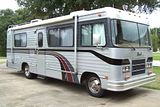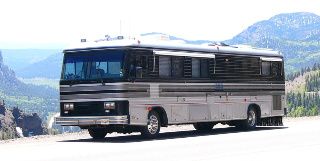Page 1 2
Go to...  | Start A New Topic  | Search  | Notify  | Tools  | Reply To This Topic  |  |
It appears my converter is not charging my house batteries. I noticed my lights going dim after a little use. Not hooked up to electricity or gen running I checked voltage at the house batteries and they were 12.7 volts. I turned on some lights and checked house batteries and still read 12.7. Turned off lights and I checked my cranking battery and it was low at 11.5 volts. Turned lights on and checked cranking battery and it showed 10.9 volts. It looks like my 12V system is drawing off my cranking battery. I have ordered a new converter and will install it when it comes in. My house batteries are old and will probably need replacing also. Any thoughts on this? Thanks, Ronnie 1985 28' P-30 454  | |||
|
Glassnose Aficionado |
Hey Ronnie, my first thought would be you have the Aux Start button engaged, tying all batteries together. The other guys here will know more than me. Are you going to Dega in October? 79 Barth Classic | |||
|
| First Month Member |
Yup. Looks like. Put a voltmeter on the coach batteries and crank the engine. If you see a voltage drop, they are connected to the start load. Do the same thing with the cranking battery. If you see a voltage drop, that is the way it is supposed to be. The two most likely places to check are the isolator (and it's switch) and the emergency start relay. I would disconnect them one at a time and see what happens. I see no reason for an isolator switch. I have never needed one in decades of motorhoming, and if I should manage things so poorly, or have a failure, I have a pre-made cable tied there ready to be connected in a trice. I also use it for allowing the alternator to power the fridge with 12 volts while driving if there isn't any sunshine for the solar panels. Search this site for isolator checking info.
Good idea. The ones that came with 85s didn't charge very well, anyway. My instructions said it would just carry the 12 volt load and would charge very little. What did you order?
Well, a lot of this depends on your batt space and your habits. If you camp off the grid a lot, a pair of 6 volt golf cart batts is the way to go. If not, a single 12 volter from a good company could be adequate. My favorite 12 volters are trolling motors. Talk to your bass fisherman buddies for the best advice on local sources. The golf cart batts are a little taller, so measure. If you are close, the posts can be cut and low terminals used to gain clearance. I had to notch the top edge of my batt compartment opening to allow the batteries to slide in and out without a spark show, also. It can't be seen with the bin door closed. Trojans are a little shorter than most others. If you are severely height-restricted, trolling batts are probably worth looking at. BTW, that'sa nica painta job for an 85. . 84 30T PeeThirty-Something, 502 powered | |||
|
Thanks for the quick reply. I looked at a drawing you posted from a search and I thought about the "emergency start switch" also. Yes I will be in Talladega September 30th through October 6th. Possibly see you there again. Ronnie 1985 28' P-30 454  | ||||
|
Thanks bill h for the info and quick response. I will test tonight. I ordered the PD9280 converter after searching on the site. We never boondock. I bought the Barth in 2003 and I'm still using the house batteries that were in it. They are 2 12V in parallel. I'll probably go with the same type batteries. I have not seen the isolator yet. I have traced wires to the engine but have not seen it. Thanks for the compliment. We had it painted in 2004 and it has held up ok. Ronnie 1985 28' P-30 454  | ||||
|
| First Month Member |
If you never boondock, it is likely that just one decent 12 volter would do the job for you, especially now that you are getting a good charger.
That's a good one. Perhaps a little big for your use, though. . 84 30T PeeThirty-Something, 502 powered | |||
|
Just checked volts at house batteries and they do drop when starting the engine. The starting battery does "not" drop when starting the engine. I took out the "emergency start relay" and the wires are soldered to the switch. There are 3 prongs on the switch. One has nothing attached. There is a wire attached to the each of the other remaining 2 prongs. Volts at one prong is equal to the cranking battery. O volts on other wired prong. When I press the switch "on" the volts on both wired prongs jump up to the house battery voltage. I think this switch is working properly. I hear a clicking when I press the switch. I traced the sound to a solinoid looking thing mounted on the passenger side frame behind the engine. Thoughts? Ronnie 1985 28' P-30 454  | ||||
|
Found the isolator. With the engine running (about 1100 rpm's - just started it and not warmed up yet)reading from the 3 prongs are 14.6V, 13.8V, and 13.8V. Ronnie 1985 28' P-30 454  | ||||
|
Other checks. "Not" hooked up to 120V, gen. not running, and engine not running. Turned on lights in cabin and saw drop in cranking battery. No drop in house batteries. Disconnect positive cable on cranking battery and lights go out. Positive battery still disconnected and can crank engine, then the house lights come on (dim at first then brighten up in a couple seconds). Kill engine and house lights go out. Ronnie 1985 28' P-30 454  | ||||
|
| First Month Member |
Not supposed to.
Supposed to.
Supposed to.
Yup. Supposed to be there.
Yup. Supposed to do that. However, an isolator does more than that. The .8 volt drop you are showing is typical of a silicone rectifier. That shows that neither diode is not open. Did you find the posts on isolator testing?
I think you need to trace every big wire. I think there could be a wiring error, perhaps in the battery bay. Or a misidentification as to which battery is which. The start battery positive wire should go to the big terminal on the starter. It's negative wire should go to ground. The engine should also be grounded. You will find some vehicles with the negative cable from the start battery to a starter mount bolt. This is a Good Thing. Either way, there should be a ground wire to the frame from the engine. The house batteries should have their grounds going straight to ground, as well. The positive terminals should be paralleled with one lead going, most likely to the starter on the genset. From there, a large lead goes to your big fuse, probably in the bottom of a closet or under a bed or couch. There will be a lead from the positive of the coach batteries and the positive of the start battery, each going to opposite terminals on the solenoid that clicks. If you have not found a wiring mistake, I would disconnect both large terminals on the emergency start solenoid and tape the hanging wire ends. Check for continuity from one large terminal to the other. There should be none. Have your wife press the emergency switch, and the solenoid should click and there should be continuity. If that works, disconnect the alt wire and start batt wire on the isolator, and put them together with a nut and bolt and insulate the connection. Delcotrons get mad if run without a load. If all the wires are correct and both the isolator and emerg start relay are disconnected, the start battery (only) should go down on engine start, and the voltage on the start battery (only) should rise. The coach batteries (only) should go down when you start the genset. (Generally, the genset is started by the coach batteries). Do you have the Barth CD? I believe there is a 1984 Regal wiring diagram there that should be very similar to yours. Or, quick and dirty, Check the wires, eliminate the isolator and solenoid, and wire the alternator directly to the start battery and let the PD charge the coach batteries. Now is a good time to make sure all your connections are nice and shiny. They like that. . 84 30T PeeThirty-Something, 502 powered | |||
|
Thanks bill h. I will continue checking as you suggested. I do have the Barth CD so I will look for the wiring diagram. I also have some papers in my Barth notebook that came with the Barth. Ronnie 1985 28' P-30 454  | ||||
|
 6/17 6/17 |
Hi, I had the same problem with my house batteries which were new. The cause was the converter becoming unplugged from the 110 volt outlet in my engine compartment. R.P.Muise 1994 Breakaway/Cummins 5.9/Allison transmission/Spartan Chassis | |||
|
bill h, you were correct on the wiring being wrong. The positive from the house battery was connected to the starter. I took that positive house battery cable off the starter and connected it to the switch and routed the cranking battery to the switch and the starter. It is all working correctly now. Both house and cranking batteries are being charged from the alternator. The emergency start switch is also working. Thanks for all the help. Ronnie 1985 28' P-30 454  | ||||
|
| ||||
|
 8/11 8/11 |
Hey Ronnie...We are neighbors! Call the shop, lets chat. 233-7494 8a - 5p Billy T Billy & Helen Thibodeaux Retired from Billy Thibodeaux's Premiere RV, Inc. Scott, LA 70583 I-10 Exit 97 The Farm is near Duson, LA I-10 Exit 92 then N 1 mile on right Three Full 50 Amp RV Hookups ! billynhelen@me.com Data Tag: 9404-3908-36XI-2C 1994 Sovereign 36' Widebody on Spartan IC (Mountain Master Lite) Chassis. Powered by Cummins ISL9-450 Onan 8,000 Quiet Diesel Genset Toad: 2018 Chevy Colorado ZR2 Diesel with M&G Car Brake  | |||
|
| Powered by Social Strata | Page 1 2 |
| Please Wait. Your request is being processed... |
|
This website is dedicated to the Barth Custom Coach, their owners and those who admire this American made, quality crafted, motor coach.
We are committed to the history, preservation and restoration of the Barth Custom Coach.
We are committed to the history, preservation and restoration of the Barth Custom Coach.


